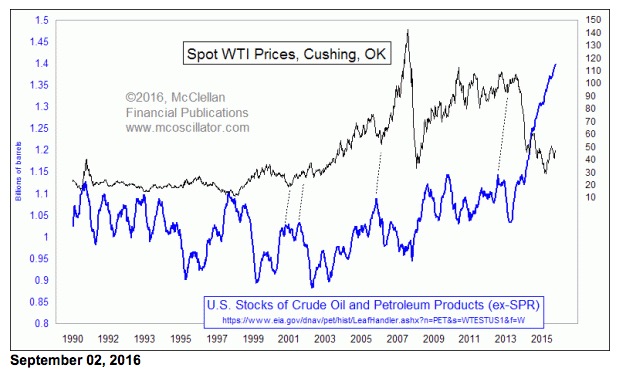
The EIA reported this week that U.S. total combined stocks of crude oil, gasoline, distillates, and other oils is at another all-time (i.e. since 1990) high, which should continue to put downward pressure on oil prices. These inventory levels used to regularly peak out at around 1.1 billion barrels, but now they are at 1.4 billion barrels. Note: Wolf Richter of wolfstreet.com has also written about this recently.
This rise blows away the scale of all of the previous fluctuations. Note that this data series does not include oil stored in the federal government’s Strategic Petroleum Reserve (SPR).
The basic idea here is that traders who own oil or distillate products do not really like the current prices, and thus they would rather pay to store them in a tank rather than sell in this market. They hope that there will be higher prices someday in the future, and they can make a profit storing the oil and waiting. The way that a rise in storage reverses itself is for prices to start higher, attracting those products back out of storage. So historically, getting up above 1.1 billion barrels in storage was a sign of a bottom for oil prices.
This time is different. Storage has blown past that former ceiling, which I suppose is great news if you own a business building storage tanks in Cushing, Oklahoma, the delivery point for settlement of WTI crude oil futures contracts. But think of the bust to come in that storage real estate market, once this trend reverses!
And think also of the depressing effect (for a while) from all that supply of petroleum coming back onto market (eventually). Owners of petroleum products will someday get tired of paying for storage rental, and leap at the chance to unload their supply onto the market. OPEC would really have to cut production by a lot to make up for all of this stored petroleum, an amount which equates to approximately 72 days of US oil consumption. And the downturn in storage supply usually precedes the bottom for oil prices, or at least that has usually been the case at past oil price bottoms.
If so, that should mean more downward pressure on stock prices as well, assuming that the correlation between the two remains a positive one.

Years ago, oil and stock prices were inversely correlated, because lower oil prices were supposedly better for business profits and consumer spending, whereas higher oil prices were inflationary and thus likely to bring higher interest rates. But when oil fell below $70 in November 2014, the relationship flipped to a positive correlation based on the worries that oil producers would not be making enough revenue on oil sales to manage the debt service on their bonds.
It has generally remained a positive correlation since then, although it was thrown off track for a while recently with all of the Brexit vote hoopla. The relationship seems to be settling down now.
If the historical behavior of crude and distillate inventories continues to work as it has in the past, the crude oil prices should not reach a bottom until after inventories top out. And thus stock market prices should be under downward pressure with falling oil prices as well.
Tom McClellan
The McClellan Market Report
www.mcoscillator.com
